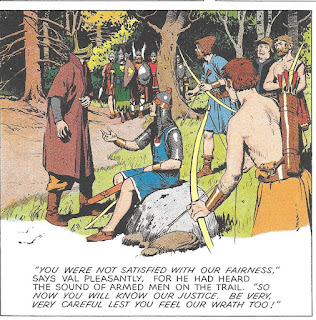I wrote an article some years ago about the War-of-1812
cruise of the USS Essex, which sailed around the Horn to the Pacific, where it
raided British shipping until it got captured by a Limey warship. The Essex was commanded by Captain David Porter and future Civil
War-era admiral David Farragut served aboard as a midshipman.
That’s why I have an immediate “Hey, that’s cool” reaction
to Yankee Buccaneer (1952), which is about Porter, Farragut and the Essex. Of
course, the movie has no relation at all to reality. It’s set after the war—no
exact year is given, but the Napoleonic Wars (which ended about the same time
as our war with the British) are said to be over. Porter is still commanding the
Essex (which in real life had ben captured by the British) and is stationed in
the Caribbean . Farragut, now a lieutenant, is
freshly assigned on board and brings secret orders with him.
Those orders are a doozy. The Essex
is to strip itself of anything that identifies it as a naval vessel and pretend
to be a pirate, then seek information on where actual pirates are hanging out.
It’s a fun film with a solid premise. Jeff Chandler plays
Porter as a strict man who follows the book. Chandler was pretty much the go-to
guy for this sort of role in the 1950s and does his typically fine job. Scott
Brady plays Farragut as very independent-minded, a trait that regularly puts
him in hot water with Porter.
Farragut is the younger of the two actors and the one who
was probably supposed to make the ladies in the movie theater swoon, so I
appreciate the fact that the movie obviously (and correctly) puts Porter in the
right for staying within orders and within regulations. Farragut risks the ship
during a storm to save a crewman, but the maneuver he orders causes damage to
the rudder and endangers everyone. This gets him in trouble. Porter, unwilling
to risk men repairing the rudder in the water in shark-infested waters, opts to slowly maneuver the
Essex to an island before making those repairs. Farragut tries to make the repairs on
his own and ends up going mano-a-mano with a shark, beating the shark but
failing to fix the rudder. This gets him in more trouble. There’s also an
identification bracelet Farragut wears with the name of one of his former
vessels on it. He keeps it for sentimental reasons even after Porter tells him
to get rid of it, which comes back to bite him in the butt big time, putting
him and the men he’s with in serious danger.
Later, while ashore on an island overseeing re-provisioning,
Farragut unexpectedly meets a beautiful Portuguese Countess. This is unusual
enough in itself. What’s more unusual is that the Countess has a pistol and
forces Farragut to take her aboard the Essex. This gets the poor lieutenant in
even more trouble with Porter.
This all, in turn, leads to a situation in which Farragut
and some of the Essex crew are prisoners of the Spanish and facing torture. Porter—the
man who prides himself on following orders—must now stretch those orders well
past the breaking point when he brings a landing party onto a technically friendly
nation and try to pull off a daring rescue.
It all really is good fun. Joseph Calleia nicely underplays
the main villain (the dishonest Spaniard), giving him an effectively sinister
air. The rest of the cast (particularly Chandler) is quite good as well. It’s a
little disappointing at the end that the Essex doesn’t deal with the actual
pirate fleet they’ve discovered (they head home to sic the rest of the American
navy on them), which means that several secondary villains we’ve met along the
way abruptly disappear from the story. Also, there’s unnecessary montage that
implies both Porter and Farragut are falling for the Countess, but there’s no
follow-up for that. But that second point is a minor quibble and the absence of
a proper resolution for some of the villains doesn’t spoil the rest of the fun.
Yankee Buccaneer is an entertaining pirate film. And, by golly, it is fun to
watch two real-life people I’ve written about team-up again for one more
adventure.
I wanted to include a clip from the movie, but it's owned by Universal, the studio that shoves you to the ground and takes your lunch money whenever you try to post a clip of one of their movies on YouTube. Sorry about that.


























































